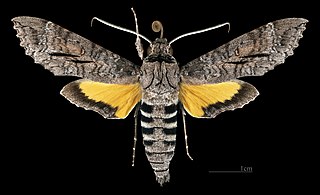
Lintneria merops is a moth of the family Sphingidae.

Callionima falcifera is a moth of the family Sphingidae first described by Bruno Gehlen in 1943. It is known from Mexico, Belize, Nicaragua, Costa Rica and Jamaica, south through northern South America.

Stolidoptera tachasara is a moth of the family Sphingidae first described by Herbert Druce in 1888.

Enyo lugubris, the mournful sphinx, is a moth of the family Sphingidae. It is found from Argentina and Paraguay to Uruguay, Venezuela, Guyana, Suriname, French Guiana, Colombia, Ecuador, Peru, Brazil and the West Indies through Belize, Guatemala, Honduras, El Salvador, Nicaragua, Costa Rica and Panama to Mexico and the United States, where it has been recorded from Arizona east to Florida and north to South Carolina. Strays have been recorded from Arkansas, north to Illinois, Michigan and New York.

Aellopos tantalus, known as the Tantalus sphinx, is a moth of the family Sphingidae. It is found in Florida, the Antilles, from Mexico to Venezuela, Colombia, Ecuador, Suriname, and in the Amazon basin.

Baniwa is a genus of moths in the family Sphingidae, containing only one species, Baniwa yavitensis, which is known from Venezuela and Amazonas and Pará in Brazil.

Aleuron chloroptera is a moth of the family Sphingidae. It was described by Maximilian Perty in 1833, and is known from southern Mexico, Brazil, Belize, Guatemala, Nicaragua, Costa Rica, Colombia, Peru, Bolivia, Venezuela, Guyana, Suriname, French Guiana, Paraguay, Argentina and Ecuador. It is probably also present in Uruguay, Honduras, El Salvador and Panama.

Aleuron iphis is a moth of the family Sphingidae. It was described by Francis Walker in 1856

Callionima inuus is a species of moth in the family Sphingidae. It was described by Walter Rothschild and Karl Jordan in 1903.

Callionima pan is a species of moth in the family Sphingidae. It was originally described by Pieter Cramer in 1779.

Enyo cavifer is a species of moth in the family Sphingidae. It was described by Rothschild and Jordan, in 1903.

Enyo taedium is a species of moth in the family Sphingidae. It was described by Schaus, in 1890.

Unzela pronoe is a moth of the family Sphingidae first described by Herbert Druce in 1894. It is found from Belize, Guatemala and Honduras to Venezuela and south to Bolivia.

Eupyrrhoglossum sagra, the Cuban sphinx, is a moth of the family Sphingidae. The species was first described by Felipe Poey in 1832. It is known from tropical and subtropical lowlands in Cuba and from Mexico and Belize to Guatemala, Costa Rica, Bolivia, Paraguay, Argentina and Uruguay. Occasionally, strays are found in Florida.

Isognathus allamandae is a moth of the family Sphingidae. It is found from Brazil to Venezuela.

Isognathus occidentalis is a moth of the family Sphingidae.

Madoryx bubastus is a moth of the family Sphingidae. It is found in Central America and South America, including French Guiana and Venezuela south to at least Bolivia and Argentina. It is also present in Mexico.

Madoryx plutonius is a moth of the family Sphingidae.

Pachygonidia subhamata is a moth of the family Sphingidae.

Perigonia ilus is a moth of the family Sphingidae first described by Jean Baptiste Boisduval in 1870.





















